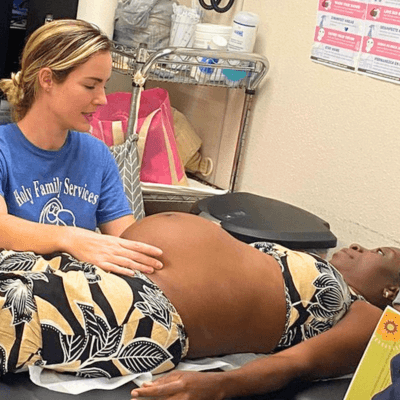High Index of Suspicion: Valley Fever in California’s Central Valley

Clinica Sierra Vista’s patient population in their Kern County, California clinics reflects this rural slice of the Central Valley, the southernmost stretch of the famously fertile and productive strip of interior California. Many of the region’s workers work outdoors. Here, where the end of the valley bumps against mountains that buffer it from the coast, the desert, and Los Angeles, the county grows and processes a wide array of agricultural products that feed the entire country: almonds, table grapes, potatoes, milk. Kern County, which is headquartered in Bakersfield, also boasts a growing clean energy industry and an extensive oil industry.
This famed valley soil, however, doesn’t just support diverse industries; it also hosts the spores of Coccidioides spp., a fungus found in pockets throughout the southwest US, Mexico, and Central America. The southern Central Valley and Central Coast are two Valley Fever hotspots. When fields are plowed, or when windstorms hit the valley, or even when large solar arrays are erected, the spores become airborne and workers and bystanders alike can breathe them in, causing infection. Around 10,000 cases of Valley Fever are reported each year in the US. Roughly 60 percent of those infected will have no or very mild symptoms -- but those who do get sick can have serious flu-like symptoms, following an incubation period of one to three weeks.
“It’s endemic -- it resides in the soil here. More recently there may have been a flare-up, having to do with the drought, but it’s always been around,” explained Sunday Irene, MD, the Chief Medical Officer of Clinica Sierra Vista. In 2016, Kern County had the highest number of cases of Valley Fever, officially called coccidioidomycosis and nicknamed “cocci,” among the counties in which the soil fungus is present. The drought resulted in dry soils that lacked plant matter, which can lead to more airborne soil. Rain brings mycelial growth, and the subsequent dry period results in hyphae desiccation and spore formation, which could increase Valley Fever's presence in the soil; conversly, more rain means wetter soil and more plant matter to hold the soil down, so a spike in cases can depend on soil disturbance. Although California’s severe drought has subsided with last year’s heavy rains, cases are still coming through Clinica Sierra Vista’s doors. In the last year, they have seen 355 cases in Kern County.
“Some patients have Valley Fever and don’t know it. They may have stayed home, the case was mild, and they recovered. What we see [here at the clinic] is just a part of what is out there,” Dr. Irene noted. “The patients that come to us are those that have more severe symptoms,” that don’t resolve. Valley Fever causes non-specific symptoms like fatigue, cough, and fever, with possible shortness of breath, and aches and soreness. Two symptoms tip off Dr. Irene and his team in particular: Valley Fever is commonly associated with rashes (erythema nodosum and erythema multiforme), and pneumonia.
“Anybody who… receives a diagnosis of pneumonia, we screen for Valley Fever. When we see patients with rash, even though it may be nonspecific and they have other symptoms, we screen for Valley Fever,” explained Dr. Irene. In the state of California, it is mandatory for clinicians to report Valley Fever.
His team is also active in education for the community, encouraging workers to wear face masks, and providing literature to help neighbors understand the dangers of airborne dust. Certain populations may have a higher risk of developing the more serious forms of Valley Fever, including pregnant women, those with weakened immune systems like people with HIV, and people with diabetes. Additionally, black and Filipino populations are particularly at risk. In Kern County, Dr. Irene sees that many members of the community know about Valley Fever because everyone knows someone who has had it. Those who have already had it may have developed immunity to it, and are at lower risk. But, as Dr. Irene noted, it's not just outdoor workers who are at risk.
“Anybody who… receives a diagnosis of pneumonia, we screen for Valley Fever. When we see patients with rash, even though it may be nonspecific and they have other symptoms, we screen for Valley Fever,”
“We stress [to patients] the need to protect themselves, but sometimes they can’t… because just being around is enough exposure,” he noted. Dr. Irene recalls young children who contracted Valley Fever just by being outside and playing in their own neighborhood. “They were just playing in the streets. Valley Fever isn’t necessarily occupational,” he emphasized.
Clinicians outside of an endemic area might not be able to recognize the illness. Dr. Irene recalls the story of a patient who stayed briefly in the Central Valley before returning to his country of origin, and became ill with Valley Fever. He was treated in the hospital for pneumonia, but he was not improving. Finally, another patient who was aware of Valley Fever tipped off the clinicians, who then correctly identified Valley Fever as the culprit and adjusted the treatment.
“Those of us who live in the Central Valley have a high index of suspicion…. But for those who are not practicing in the Central Valley, [they should] have it in the back of their mind to ask about travel if the patient has pneumonia or nonspecific symptoms like rash,” Dr. Irene noted.
“It’s important as clinicians when we take history to ask about travel history. That can be instrumental in raising the suspicion and thinking about Valley Fever.”
Learn more about Valley Fever causes, symptoms, and treatment: The California Department of Public Health’s Occupational Health Branch has a free CME course for health care providers on Valley Fever that has been recently updated: https://cmecalifornia.com/Activity/5210283/Detail.aspx#lnk5210283.
The National Institute for Occupational Safety and Health (NIOSH) has a Valley Fever page with numerous resources related to occupational health: https://www.cdc.gov/niosh/topics/valleyfever/default.html.
In California, employers are required to report cases of Valley Fever as an occupational illness, and issue citations to those who don't. Read more at the Cal/OSHA Valley Fever page: https://www.dir.ca.gov/dosh/valley-fever-home.html.
The Kern County Public Health Services Department maintains its own Valley Fever site specific to the Central Valley with resources and information relevant to areas outside the county: http://kerncountyvalleyfever.com/.
The Centers for Disease Control and Prevention (CDC)’s Valley Fever Awareness page gives some basics of the infection and the CDC’s approach: https://www.cdc.gov/features/valleyfever/index.html.
Read more about the importance and the “art” of taking a patient history, written by MCN’s Co-Chief Medical Officer, Dr. Ed Zuroweste: http://www.migrantclinician.org/blog/2014/oct/how-do-we-avoid-another-ehr-mishap-part-two.html.
Clinica Sierra Vista operates in Fresno, Kern, and Inyo counties: https://clinicasierravista.org/.
Like what you see? Amplify our collective voice with a contribution.
Got some good news to share? Send it to us via email, on Facebook, or on Twitter.
Return to the main blog page or sign up for blog updates here.
- Log in to post comments






